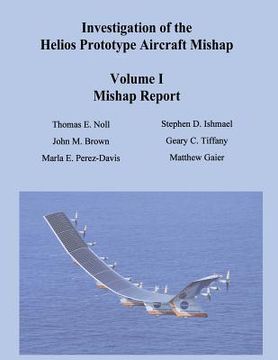Investigation of the Helios Prototype Aircraft Mishap - Volume I Mishap Report (en Inglés)
Reseña del libro "Investigation of the Helios Prototype Aircraft Mishap - Volume I Mishap Report (en Inglés)"
The Helios Prototype vehicle was one of several remotely piloted aircraft funded and developed by NASA under the Environmental Research Aircraft and Sensor Technology (ERAST) project, and managed by NASA's Dryden Flight Research Center (DFRC). This vehicle was a proof-of-concept, propeller-driven, flying wing built and operated by AeroVironment, Inc. The vehicle consisted of two configurations. One configuration, designated HP01, was designed to operate at extremely high altitudes using batteries and high-efficiency solar cells spread across the upper surface of its 247-foot wingspan. On 13 August 2001, this aircraft configuration reached an altitude of 96,863 feet, a world record for sustained horizontal flight by a winged aircraft. The other configuration, designated HP03, was designed for long-duration flight. The plan was to use the solar cells to power the vehicle's electric motors and subsystems during the day and to use a modified commercial hydrogen-air fuel cell system for use during the night. The vehicle was also equipped with batteries as a backup source of power. The aircraft design used wing dihedral, engine power, elevator control surfaces, and a stability augmentation and control system to provide aerodynamic stability and control. On 26 June 2003, HP03-2 took off at 10:06am local time from the Navy's Pacific Missile Range Facility (PMRF) located on the island of Kauai, Hawaii. The aircraft was under the guidance of AeroVironment, Inc. (AV) ground-based mission controllers. At that time the environmental wind conditions appeared to be within an acceptable envelope, and consisted of a wind shadow over and offshore from PMRF, bounded to the north, south, and above by zones of wind shear and turbulence separating this region from the ambient easterly trade-wind flow. However, compared to previous solar-powered flights from PMRF, HP03-2 was subject to longer exposure to the low-level turbulence in the lee of Kauai due to the shallower climb out trajectory. The vehicle's longer exposure to Kauai's lee side turbulence and lower shear line penetration were superposed on what the Board now recognizes as greater airplane sensitivity to turbulence and may have been compounded by the apparent narrow corridor between the shear lines noted by the chase helicopter observer. At 10:22am and 10:24am, the aircraft encountered turbulence and the wing dihedral became much larger than normal and mild pitch oscillations began, but quickly damped out. At about 30 minutes into the flight, the aircraft encountered turbulence and morphed into an unexpected, persistent, high dihedral configuration. As a result of the persistent high dihedral, the aircraft became unstable in a very divergent pitch mode in which the airspeed excursions from the nominal flight speed about doubled every cycle of the oscillation. The aircraft's design airspeed was subsequently exceeded and the resulting high dynamic pressures caused the wing leading edge secondary structure on the outer wing panels to fail and the solar cells and skin on the upper surface of the wing to rip off. The aircraft impacted the ocean within the confines of the PMRF test range and was destroyed. The crash caused no other property damage or any injuries to personnel on the ground. Most of the vehicle structure was recovered except the hydrogen-air fuel cell pod and two of the ten engines, which sank into the ocean. The root causes of the mishap include: Lack of adequate analysis methods led to an inaccurate risk assessment of the effects of configuration changes leading to an inappropriate decision to fly an aircraft configuration highly sensitive to disturbances, and Configuration changes to the aircraft, driven by programmatic and technological constraints, altered the aircraft from a spanloader to a highly point-loaded mass distribution on the same structure significantly reducing design robustness and margins of safety.

